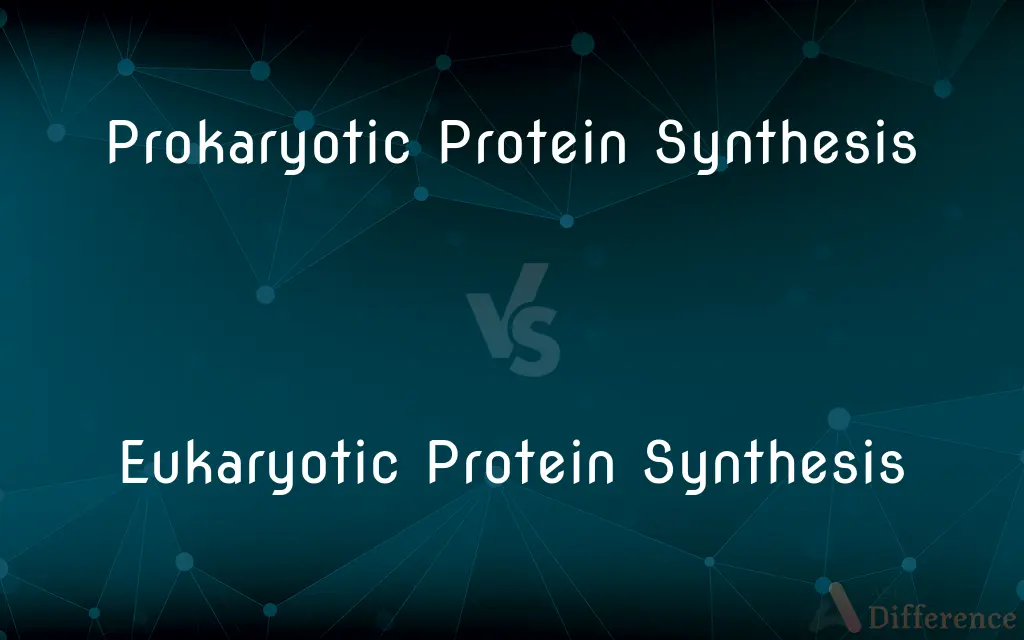Prokaryotic Protein Synthesis vs. Eukaryotic Protein Synthesis — What's the Difference?
Edited by Tayyaba Rehman — By Fiza Rafique — Published on November 2, 2024
Prokaryotic protein synthesis occurs in cytoplasm, involves fewer initiation, and coupled with transcription. Eukaryotic protein synthesis occurs in cytoplasm and on the endoplasmic reticulum, involves more initiation, and is separated from transcription.

Difference Between Prokaryotic Protein Synthesis and Eukaryotic Protein Synthesis
Table of Contents
ADVERTISEMENT
Key Differences
Prokaryotic protein synthesis is characterized by its occurrence solely in the cytoplasm due to the absence of a nucleus, facilitating the coupling of transcription and translation. In contrast, eukaryotic protein synthesis can occur both in the cytoplasm and on the rough endoplasmic reticulum, with transcription and translation processes being spatially and temporally separated due to the presence of a nuclear membrane.
The initiation phase of protein synthesis in prokaryotes requires fewer initiation factors and is generally simpler, reflecting the organisms' overall simpler structure. On the other hand, eukaryotic protein synthesis involves a more complex set of initiation factors and additional processes like capping, splicing, and polyadenylation of mRNA before translation can occur.
In prokaryotes, ribosomes can attach to mRNA and begin translation even before transcription has finished, thanks to the proximity of these processes. Eukaryotes, however, must transport mRNA out of the nucleus and often modify it before translation begins, highlighting a more compartmentalized and regulated approach.
The ribosomes of prokaryotes (70S) are smaller and slightly different in structure and composition than those of eukaryotes (80S), which affects the mechanisms of translation and the sensitivity to certain antibiotics. This difference underlines the distinct evolutionary paths and cellular complexities of these two life forms.
The post-translational modifications in eukaryotic proteins are generally more complex and varied, including folding, cleavage, and addition of various functional groups, reflecting the higher complexity and specificity required by eukaryotic cells. Prokaryotic proteins also undergo post-translational modifications, but these are typically simpler and less diverse.
ADVERTISEMENT
Comparison Chart
Location
Cytoplasm
Cytoplasm and rough endoplasmic reticulum
Coupling with Transcription
Coupled with transcription
Separated from transcription
Initiation Factors
Fewer, simpler initiation factors
More, complex initiation factors
Ribosome Size
70S (50S and 30S subunits)
80S (60S and 40S subunits)
MRNA Processing
Direct translation without extensive processing
Requires capping, splicing, and polyadenylation before translation
Post-translational Modifications
Simpler and less diverse
More complex and varied
Sensitivity to Antibiotics
Different sensitivities due to ribosome structure
Less sensitive to antibiotics targeting prokaryotic ribosomes
Compare with Definitions
Prokaryotic Protein Synthesis
Involves 70S ribosomes, unique to prokaryotes, affecting antibiotic sensitivity.
Erythromycin targets the 50S subunit of prokaryotic ribosomes.
Eukaryotic Protein Synthesis
More sensitive to cellular regulation and environmental signals.
Eukaryotic cells can regulate protein synthesis in response to stress by phosphorylating eIF2.
Prokaryotic Protein Synthesis
Directly translates mRNA into protein without extensive processing.
MRNA in prokaryotes is polycistronic, coding for multiple proteins.
Eukaryotic Protein Synthesis
Requires more complex initiation and post-translational modifications.
Eukaryotic proteins often undergo folding with chaperones and glycosylation.
Prokaryotic Protein Synthesis
Less compartmentalization in protein synthesis processes.
The lack of a nucleus in prokaryotes facilitates the direct transition from transcription to translation.
Eukaryotic Protein Synthesis
Involves transcription in the nucleus and translation in the cytoplasm or ER.
Human cells modify mRNA with a 5' cap and poly-A tail before translation.
Prokaryotic Protein Synthesis
Characterized by simpler initiation and fewer post-translational modifications.
In bacteria, proteins are often functional immediately after synthesis.
Eukaryotic Protein Synthesis
Uses 80S ribosomes, distinct from prokaryotic ribosomes.
Cycloheximide specifically inhibits eukaryotic 80S ribosome function.
Prokaryotic Protein Synthesis
Occurs in the cytoplasm, allowing simultaneous transcription and translation.
Bacterial cells synthesize proteins directly from mRNA without nuclear processing.
Eukaryotic Protein Synthesis
MRNA processing includes splicing, capping, and polyadenylation.
Introns are removed from eukaryotic mRNA in the nucleus before it's translated.
Common Curiosities
What role does mRNA processing play in eukaryotic protein synthesis?
mRNA processing, including capping, splicing, and polyadenylation, is crucial for the stability and translation efficiency of eukaryotic mRNA.
Why can transcription and translation be coupled in prokaryotes?
The lack of a nuclear membrane in prokaryotes allows these processes to occur simultaneously in the cytoplasm.
What distinguishes prokaryotic from eukaryotic protein synthesis?
The main distinctions include the cellular location, complexity of initiation, ribosome size, mRNA processing, and post-translational modifications.
Why are post-translational modifications more complex in eukaryotes?
The higher complexity of eukaryotic cells requires more diverse and specific protein functions, necessitating varied modifications.
How do ribosome sizes affect protein synthesis?
Ribosome size (70S in prokaryotes, 80S in eukaryotes) influences the mechanisms of translation and sensitivity to antibiotics.
What is the significance of the rough endoplasmic reticulum in eukaryotic protein synthesis?
The rough ER is involved in the synthesis of membrane-bound and secretory proteins, providing a site for translation and post-translational modifications.
How do antibiotics differentiate between prokaryotic and eukaryotic ribosomes?
Many antibiotics target specific structural differences in prokaryotic ribosomes without affecting eukaryotic ribosomes.
Can eukaryotic cells regulate protein synthesis?
Yes, eukaryotic cells regulate protein synthesis through various mechanisms, including phosphorylation of initiation factors in response to environmental signals.
How does the complexity of initiation factors affect protein synthesis?
The complexity of initiation factors in eukaryotes allows for tighter regulation of translation, adapting to cellular needs and conditions.
Why is the separation of transcription and translation important in eukaryotes?
This separation allows for extensive RNA processing and regulatory mechanisms, ensuring proper gene expression and protein function.
Share Your Discovery

Previous Comparison
Mediator vs. Conciliator
Next Comparison
Krill Oil vs. Fish OilAuthor Spotlight
Written by
Fiza RafiqueFiza Rafique is a skilled content writer at AskDifference.com, where she meticulously refines and enhances written pieces. Drawing from her vast editorial expertise, Fiza ensures clarity, accuracy, and precision in every article. Passionate about language, she continually seeks to elevate the quality of content for readers worldwide.
Edited by
Tayyaba RehmanTayyaba Rehman is a distinguished writer, currently serving as a primary contributor to askdifference.com. As a researcher in semantics and etymology, Tayyaba's passion for the complexity of languages and their distinctions has found a perfect home on the platform. Tayyaba delves into the intricacies of language, distinguishing between commonly confused words and phrases, thereby providing clarity for readers worldwide.













































